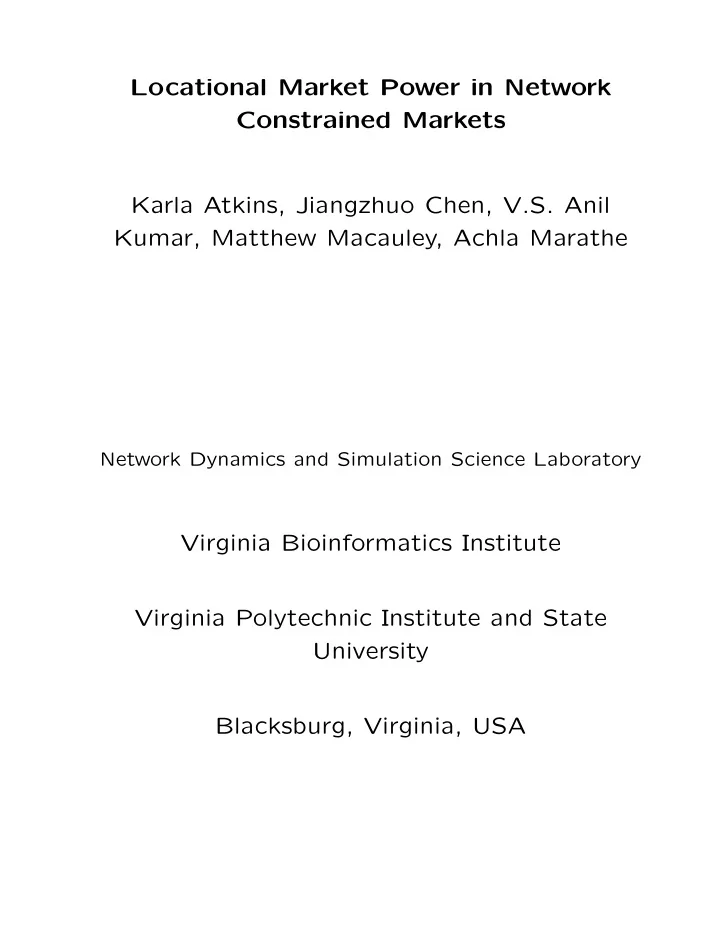

Locational Market Power in Network Constrained Markets Karla Atkins, Jiangzhuo Chen, V.S. Anil Kumar, Matthew Macauley, Achla Marathe Network Dynamics and Simulation Science Laboratory Virginia Bioinformatics Institute Virginia Polytechnic Institute and State University Blacksburg, Virginia, USA
Quantifying transmission-level market power “Seller i has P i units of market power if the de- mand that can be supplied in the absence of i decreases by P i .” Similarly, we can define the market power P S of a group S of sellers by viewing them as a single entity. Example. If demand D = 10 and 3 sellers can supply s 1 = 9, s 2 = 5, s 3 = 3, then they have market power P 1 = 2, P 2 = 0, P 3 = 0, and moreover, P 12 = 7, P 13 = 5, P 23 = 1, P 123 = 10 Theorem. Market power is supermodular.
Network Model • � 9 � � 9 � � � � � � � � � � � � � � � � 5 5 10 • t � � � � � � s • � • • � � � � � � � � � � � � � � � � � 3 3 � � � � � � � � � • s is a “super-source” t is a “super-sink” Now, fulfilling the total demand of D = � d i amounts to finding a concurrent feasible network s - t flow of capacity D .
Questions • How bad can market power get by forming coalitions? • How does locational topology affect market power? • How does market power behave over a real- world network? • How does supply and demand elasticity affect market power?
Experiments Used the power grid of Portland, Oregon. 776 lines, 662 nodes (319 load-serving, 41 gen- erators) Peak demand: 6986 . 62 MW. 4 scenerios: Each of supply and demand can be elastic or inelastic.
Inelastic supply, inelastic demand Generators are described by two characteristics: 1. Production capacity 2. Location on the network • A generator’ production capacity and mar- ket power are surprisingly not strongly cor- related. • A generator’s degree and market power are highly correlated (the top 8 of each are iden- tical!) Generator 98: Controls 15% of capacity, has 0.1% market power. Generator 83: Controls 10% of capacity, has 60% market power. Generator 130: Controls 1.34% of capacity, has 10.16% market power.
Market power under coalitions Experimentally: Generators that belong to the most powerful size- k coalition are also members of the most powerful size-( k + 1) coalition. This fails in general: 2 • • � 2 � � 2 � � � � � � � � � � � � � � � � 8 10 • t � � � � s • � � � • • � � � � 8 � � � � � � � � � � � � � � � � � � � 8 � � � 8 � � � � � � � � � � � � � • • 8 D = 10, P 1 = 2, P 2 = 0, P 3 = 0 P 12 = 2, P 13 = 2, P 23 = 8
Larger coalitions • The top-20 size-3 coalitions all have at least 70% market power. • The top-20 size-4 coalitions all have at least 79% market power. • The top-20 size-5 coalitions all have at least 87% market power. • The top-20 size-6 coalitions all have at least 90% market power.
Elasticity and market power • Demand elasticity is negatively correlated with market power. • Supply elasticity is positively correlated with market power. • Supply is more elastic than demand, thus market power is positively correlated with the MCP.
Avg Market Power vs Price Inelastic Demand Elastic Supply: 2−generator 24500 avg market power 24480 24460 24440 20 22 24 26 28 30 price Avg Market Power vs Price Elastic Demand, Inelastic Supply: 2−generator 24426 24424 avg market power 24422 24420 24418 20 22 24 26 28 30 price Avg Market Power vs Price Elastic Demand, Elastic Supply: 2−generator 24490 avg market power 24470 24450 24430 20 22 24 26 28 30 price
Avg Market Power vs Price Inelastic Demand Elastic Supply: 2−generator 24500 avg market power 24480 24460 24440 20 22 24 26 28 30 price Avg Market Power vs Price Elastic Demand, Inelastic Supply: 2−generator 24426 24424 avg market power 24422 24420 24418 20 22 24 26 28 30 price
Recommend
More recommend